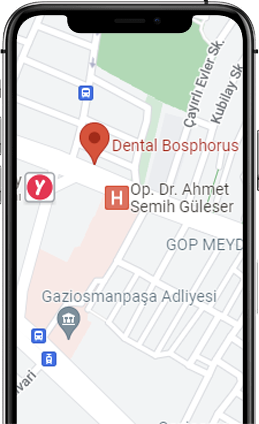What is Gum Disease?
Gum disease is the inflammation of the gums that surrounds and supports the tooth, which may progress to the bone. The main cause of gum disease is bacteria in the sticky and colorless plaque that often forms on the teeth.
The tissues surrounding your teeth consist of both hard and soft structures. These tissues are very important for your oral and dental health. Any discomfort in this area will also affect your body health in general.
Problems such as inflammation of the gums and osteoporosis are the main subjects of periodontology. It is very important to treat gum disease by using the most appropriate treatment method to save the tooth and eliminate inflammation.

What are the Symptoms of Gum Diseases?
- Bleeding gums while brushing teeth.
- Red, swollen and tender gums.
- Bad breath.
- Recession in the gums.
- Gums that can be easily separated from the teeth.
- Inflammatory discharge between the teeth and gums.
- Teeth that wobble or move away from each other (creation of gaps between teeth or increasing existing gaps).
- Change of sensitivity between upper and lower teeth during biting.
- It is the change in the fit of the existing prosthesis.
What are the Causes of Gum Disease?
The most important factor in the formation of gum diseases is improper oral care. Improvement in oral care often leads to improvement. Another important factor is hereditary reasons. Some gum diseases begin at an early age and progress quite rapidly. If this situation is not taken under control, even the loss of all teeth can be seen at the age of 30-40.
One of the most important enemies of gums is smoking. With the harmful substances in cigarettes and the effect of heat, irreversible damage is seen in the gums and teeth. One of the biggest harms of smoking is that it hides the bleeding of the gums and makes it difficult to detect the gum disease. In addition to these reasons, other important causes of dental disease are as follows.

Drugs That Cause Gum Growth: Some drugs used in epilepsy disease cause growth in the gums and facilitate food accumulation.
Pregnancy: Hormonal changes and brushing difficulties during this period often return as gum discomfort and tooth loss.
Adolescence: Adolescence is a bad period for gingival disorders due to temporary hormonal changes such as pregnancy and problems such as brushing habits. In some children, adenoid and tonsil problems can cause both gum disease and orthodontic problems.
Orthodontic Problems: Tooth crowding causes deformities in the jawbone, formation of gingival folds and difficulty in brushing. If the jaw curves are corrected with orthodontic treatment, gum problems are also reduced considerably.
Traumas: As a result of habits that put pressure on the teeth and incorrect brushing, gingival recession can be seen. In order to prevent these recessions, it is necessary to use soft toothbrushes and brush with appropriate technique.
What are the Treatment Methods for Gum Disease?
Periodontologists apply surgical and non-surgical treatment methods such as tooth surface cleaning, root surface straightening, curettage procedures, occlusal arrangements.

- Surgical treatment of gingival recessions,
- Surgical treatment of gingival enlargements,
- Surgical applications to treat tissue loss due to gingival diseases,
- Bone grafts, membrane applications, soft tissue grafts,
- Removal of plaque and tartar that causes gum disease
- Correction of malformed gums due to genetic disease or trauma.
- Informing the patient about oral hygiene.
- Treatment of gum infections with non-surgical methods.
- Surgical treatment of gingivitis under local anesthesia.
Early diagnosis is very important in periodontology.
Therefore, make an appointment for periodontal examination by our specialists



